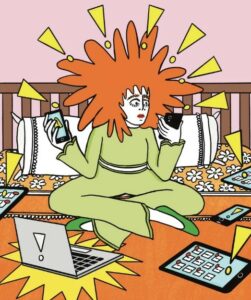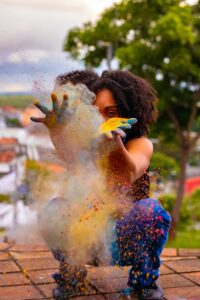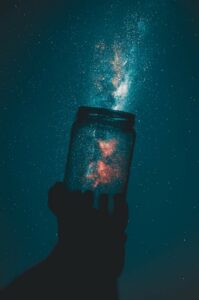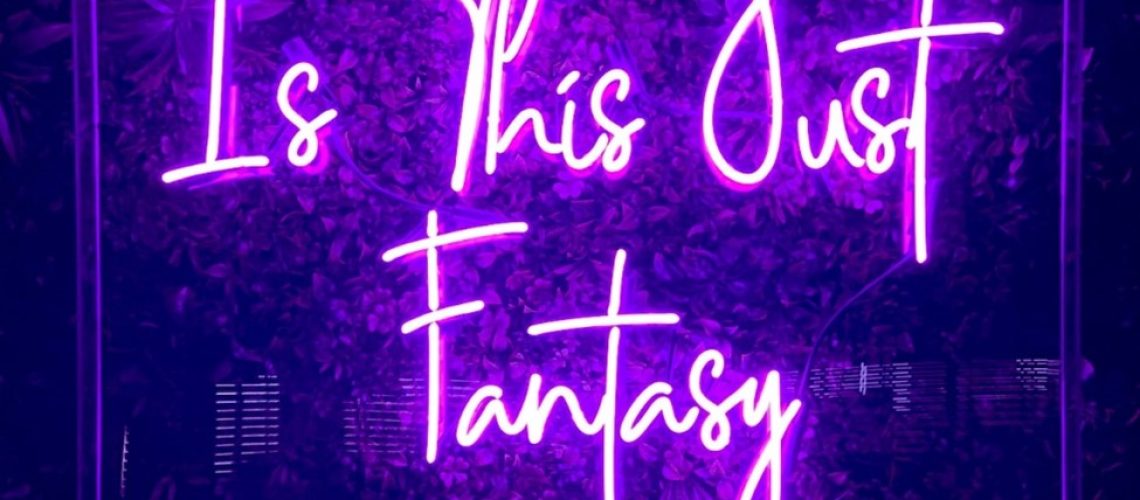Guest Post by Julia Branstrator, 2022-2023 Sustainability Leadership Fellow, and Ph.D. Candidate in the Department of Human Dimensions of Natural Resources at Colorado State University
How does creativity, imagination, or emotion relate to our resilience and resistance during crises and disasters?
As many students, faculty, and administrators may empathize or sympathize, I did not anticipate a journey in education through a pandemic. Days behind screens quarantined inside, uncertain of the world and its inhabitants outside, did not make for a healthy mindset. I felt my thirst for academic pursuit dwindled by anxiety and being consumed with life in “survival mode” – feelings to which many can relate. We watched, consumed, and internalized conflict as the pandemic layered social, political, economic, and climate crises.

Terms such as “doomscrolling” (Hernández, 2022) became commonplace in conversations sharing about the day. Rather than echoing a tone of gloom, this reflection comes from a place of inspiration and gratitude. Life is still permeated by those privileged to remain in education, work, or in decent health (albeit worse for wear), sating our thirst to continue in our life pursuits. What have we learned through shared ongoing trials that may lead to a better future? I invite you, dear reader, to explore this with me through the realms of affect, emotion, and creative expression. For as we progress through this new year, uncertain of the times ahead, we can reflect on how we experience and express our affective selves as practices of personal resilience and resistance.
In the wake of our new world irrevocably changed by the pandemic, research utilizing the term “resilience” has grown with zeal (Butler, 2022). In this growth, the term has taken on vast meanings in its adaptation to disciplines outside its academic origins of ecology and engineering. Some warn that the meaning of “resilience” has been diluted for “maladaptive political means and thus hamper the effectiveness of genuine attempts to mitigate damage” (Soubry & Sherren, 2022, p.1). Existing research may guide interested readers through in-depth literature reviews to break down interdisciplinary histories and meanings of the term “resilience” (Liu et al., 2007; Wied et al., 2020; Fletcher & Sarker, 2013; Bec et al., 2016; Cheer et al., 2017), and demonstrate its different applications across disciplines today.

Specifically referring to the realm of individual resilience, I offer a perspective that provided me with great comfort, and inspired compassion for myself and others as kin of troubled times (Ray, 2020; Harway; 2016). As individuals, we are part of dynamic globalized systems changing our relationships to ourselves, one another, and our planet. Understanding that individuals are connected to greater systems, in A Field Guide to Climate Anxiety, Sarah Ray (2020) describes individual resilience as “bound up with resistance”, embodied in culturally sensitive ways, and learning how to be with grief and limitations “even while finding efficacy and healing in your power to act” (p.141). Ray highlights from Paul Outka’s Environmentalism After Despair:
“Just as there is no return to the Garden or the Wilderness, there is no environmentalism of despair. Resilience is a post-despair environmentalism, which isn’t (at all) the same as optimism or thinking it’s all going to work out fine—it’s finding yourself still alive the day after, with some fight left…Rather than trying to get it right, or get it right again, resilience is trying to keep it going here, there, anywhere, everywhere” (2014, p.2)
Why am I connecting affective, creative expressions, emotion, and moods to individual resilience through crises? Much like the realm of sustainability in a globalized world, the pandemic has unearthed complex, overwhelming problems. In times of crisis and isolation, art and creative outlets made anything possible at a time when the possibility of positive news seemed anything but (Netter, 2020). Staying in place allowed for introspective exploration of our emotional, affective, and psychological states as embodied reflections of the world around us. Though definitions vary widely, emotions may be understood as social and cultural expressions of personal, subjective “sociolinguistic fixing of the quality of an experience” (Mazzarella, 2020, p.292).  Affect more broadly describes “other-than-conscious potentiality that can be brought on the surface…an intensity that when spiked, can become perceivable as emotion” (Martini & Buda, 2021, p.680; Massumi, 2002; Ngai, 2007). In some research and application, affect theory can utilize such concepts in ways “that appraises the historical and cultural contexts of emotions as expressed through art and politics” (Allen, 2021, p.403). Beyond having more terms to describe the ways we feel, why does it matter how we describe and express emotions and affect such as fear, dread, anger, optimism, loneliness, and joy during the pandemic? Of special interest between you and I, dear reader, is our emotional awareness and its ability to affect others in powerful ways across myriads of disciplines, differences, and channels of communication. Our introspective emotional reflection may extend in ways affecting others for societal, political, and environmental change; mirroring ways of feeling for health and wellbeing through ways of living with our surroundings in healthy, reciprocal ways.
Affect more broadly describes “other-than-conscious potentiality that can be brought on the surface…an intensity that when spiked, can become perceivable as emotion” (Martini & Buda, 2021, p.680; Massumi, 2002; Ngai, 2007). In some research and application, affect theory can utilize such concepts in ways “that appraises the historical and cultural contexts of emotions as expressed through art and politics” (Allen, 2021, p.403). Beyond having more terms to describe the ways we feel, why does it matter how we describe and express emotions and affect such as fear, dread, anger, optimism, loneliness, and joy during the pandemic? Of special interest between you and I, dear reader, is our emotional awareness and its ability to affect others in powerful ways across myriads of disciplines, differences, and channels of communication. Our introspective emotional reflection may extend in ways affecting others for societal, political, and environmental change; mirroring ways of feeling for health and wellbeing through ways of living with our surroundings in healthy, reciprocal ways.
In relating individual resilience to creative expression, I ask you to think of your own relationship with creativity. In my dissertation fieldwork, I focused on exploring individual experiences during the pandemic within this question. I was met with a variety of responses ranging from painting, writing, and photography to community service, work, hiking or attending live music. Some respondents felt they were not the “creative type”, but still appreciated or connected to creative outlets (e.g., music, art). Creative expression is “an incremental building process of responsive acts” (McNiff, 2015, p.12). This transcends the individual scope when considering our connections within social systems. There are many descriptions that may be applied when discussing creative expression to relate individual resilience as a scaled aspect of a shared creative process.  In considering collective or group dynamics, we are connected through creative processes “whereby the varied elements and figures of our most intimate selves, inside and outside awareness, create together” (McNiff, 2015, p.12). During times of abrupt and drastic change, how do you think creative outlets related to individual resilience and wellbeing? Executive Producer of the nonprofit Alliance for Young Artists & Writers, Christopher Wisniewski, shares in his experience that creative expression acknowledges and honors what we have lived in ways “that can be shared with others across any distance [and] provides opportunities for empathy” (Wisniewski, 2020, para. 10). In this sense, individual creative expression can reflect our connections to self and others in our increasingly complex world.
In considering collective or group dynamics, we are connected through creative processes “whereby the varied elements and figures of our most intimate selves, inside and outside awareness, create together” (McNiff, 2015, p.12). During times of abrupt and drastic change, how do you think creative outlets related to individual resilience and wellbeing? Executive Producer of the nonprofit Alliance for Young Artists & Writers, Christopher Wisniewski, shares in his experience that creative expression acknowledges and honors what we have lived in ways “that can be shared with others across any distance [and] provides opportunities for empathy” (Wisniewski, 2020, para. 10). In this sense, individual creative expression can reflect our connections to self and others in our increasingly complex world.
As the final stop in our journey together, my dear reader, I’d like to share how I have found my own creative expression as individual resilience through compounding crises such as climate change, the pandemic, economic uncertainty, and social injustice.

Though sustainability and climate studies are rarely clouds with silver linings, I have found reflection and catharsis within creative writing and communication that connects different realms of thought. Sustainability studies and practices draw from interdisciplinary thinking, conflicting and cooperating across worldviews and philosophies. Sustainability learning communities have shown me that common languages can be constructed drawing from shared values and emotions related to climate anxiety such as determination and pessimistic hope (Witlacil, 2022). In this practice, I may reflect on the fears, inspirations, and frustrations that permeate my psyche from global, national, and local spheres of influence. I also draw from imaginative and playful thought, finding social spaces that allow for building agency to write, speak, and act. And so, my dear reader, find your resistance and resilience within these affective expressions and spaces of creativity. Share with others different ways of knowing through play, imagination, and emotion. This simultaneous process of emotional awareness, reflection, and creation may combat paralyses of hopelessness. By sharing these productions within interdisciplinary learning groups, we may reciprocally affect each other through the exchange of knowledge and values for a future in which our actions and feelings are reflected in our relationship to the world, and each other.
References
Allen, B. (2021). Emotion and COVID-19: Toward an equitable pandemic response. Journal of Bioethical Inquiry, 18(3), 403-406.
Bec, A., McLennan, C. L., & Moyle, B. D. (2016). Community resilience to long-term tourism decline and rejuvenation: A literature review and conceptual model. Current Issues in Tourism, 19(5), 431-457.
Butler, R. (2022). The meaning(s) and implications of resilience for tourist destinations. University of Oulu, November 7th, 2022. https://www.oulu.fi/en/events/genz-seminar-building-resilient-destinations-times-global-changes
Cheer, J. M., Cole, S., Reeves, K. J., & Kato, K. (2017). Tourism and Islandscapes: Cultural realignment, social-ecological resilience and change. Shima, 11(1).
Fletcher, D., & Sarkar, M. (2013). Psychological resilience: A review and critique of definitions, concepts, and theory. European psychologist, 18(1), 12.
Fullagar, S., & Pavlidis, A. (2021). Thinking through the disruptive effects and affects of the coronavirus with feminist new materialism. Leisure sciences, 43(1-2), 152-159.
Haraway, D. J. (2016). Staying with the trouble: Making kin in the Chthulucene. Duke University Press.
Hernández, C.R. (2022, July 18). Study finds “Doomscrolling” is a new, unique behavior. UF College of Journalism and Communications. Retrieved January 5, 2023, from https://www.jou.ufl.edu/insights/study-finds-doomscrolling-is-a-new-unique-behavior/
Jamrog, K. A. (2021, April 19). Stressed from the pandemic? you may be drawn to Doomscrolling. New Hampshire Magazine. Retrieved January 29, 2023, from https://www.nhmagazine.com/how-to-stop-doomscrolling-and-feel-better/
Martini, A., & Buda, D. M. (2020). Dark tourism and affect: Framing places of death and disaster. Current Issues in Tourism, 23(6), 679-692.
Liu, J., Dietz, T., Carpenter, S. R., Alberti, M., Folke, C., Moran, E., … & Taylor, W. W. (2007). Complexity of coupled human and natural systems. science, 317(5844), 1513-1516.
Massumi, B. (2002). Parables for the virtual: Movement, affect, sensation. Duke University Press.
Mazzarella, W. (2020). Affect: What is it Good for?. In Enchantments of modernity (pp. 291-309). Routledge India.
Netter, L. (2022, September 13). The importance of art in the time of coronavirus. The Conversation. Retrieved January 5, 2023, from https://theconversation.com/the-importance-of-art-in-the-time-of-coronavirus-135225
Ngai, S. (2007). Ugly feelings. Harvard University Press.
Outka, P. (2014). Environmentalism after Despair. Resilience: A Journal of the Environmental Humanities, 1(1).
Ray, S. J. (2020). A field guide to climate anxiety: How to keep your cool on a warming planet. Univ of California Press.
Soubry, B., & Sherren, K. (2022). ” You keep using that word…”: Disjointed definitions of resilience in food systems adaptation. Land Use Policy, 114, 105954.
Wied, M., Oehmen, J., & Welo, T. (2020). Conceptualizing resilience in engineering systems: An analysis of the literature. Systems Engineering, 23(1), 3-13.
Witlacil, M. (2022). Acts of Pessimistic Hope for the Anthropocene. Human Nature Blog. School of Global Environmental Sustainability. Available at: https://sustainability.colostate.edu/humannature/acts-of-pessimistic-hope-for-the-anthropocene/
Wisniewski, C. (2020, May 6). Why creativity matters during a crisis. EDU. Retrieved January 23, 2023, from https://edublog.scholastic.com/post/why-creativity-matters-during-crisis






